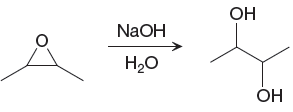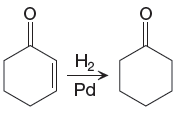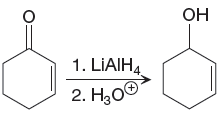
Concept explainers
(a)
Interpretation:
The differences in the IR spectra of the reactant and product that would enable you to tell that the given reaction has taken place are to be determined.
Concept introduction:
The frequencies of the stretching vibrations are estimated from the type of bond and the frequency range given for that bond. Also, the frequency range for the given type of bond is identified by the
Answer to Problem 15.41P
An OH stretch with stretching frequency
Explanation of Solution
The given reaction is

In the above reaction, the OH group, that is the alcohol functional group, is present in the reactant, and C=C bond of
The differences in the IR spectra that would enable to tell that the given reaction has taken place are determined on the basis of bonds and the functional groups present in the reactant and the product.
(b)
Interpretation:
The differences in the IR spectra of the reactant and product that would enable you to tell that the given reaction has taken place are to be determined.
Concept introduction:
The frequencies of the stretching vibrations are estimated from the type of bond and the frequency range given for that bond. Also, frequency range for the given type of bond is identified by the functional group to which that bond resembles in the molecule.
Answer to Problem 15.41P
A very broad OH stretch having stretching frequency
Explanation of Solution
The given reaction is

The
The differences in the IR spectra that would enable to tell that the given reaction has taken place are determined on the basis of bonds and the functional groups present in the reactant and the product.
(c)
Interpretation:
The differences in the IR spectra of the reactant and product that would enable you to tell that the given reaction has taken place are to be determined.
Concept introduction:
The frequencies of the stretching vibrations are estimated from the type of bond and the frequency range given for that bond. Also, frequency range for the given type of bond is identified by the functional group to which that bond resembles in the molecule.
Answer to Problem 15.41P
Two
Explanation of Solution
The given reaction is,

Two
The differences in the IR spectra that would enable to tell that the given reaction has taken place are determined on the basis of bonds and the functional groups present in the reactant and the product.
(d)
Interpretation:
The differences in the IR spectra of the reactant and product that would enable you to tell that the given reaction has taken place are to be determined.
Concept introduction:
The frequencies of the stretching vibrations are estimated from the type of bond and the frequency range given for that bond. Also, frequency range for the given type of bond is identified by the functional group to which that bond resembles in the molecule.
Answer to Problem 15.41P
The single N-H band having stretching frequency
Explanation of Solution
The given reaction is

The single N-H band having stretching frequency
The differences in the IR spectra that would enable to tell that the given reaction has taken place are determined on the basis of bonds and the functional groups present in the reactant and the product.
(e)
Interpretation:
The differences in the IR spectra of the reactant and product that would enable you to tell that the given reaction has taken place are to be determined.
Concept introduction:
The frequencies of the stretching vibrations are estimated from the type of bond and the frequency range given for that bond. Also, frequency range for the given type of bond is identified by the functional group to which that bond resembles in the molecule.
Answer to Problem 15.41P
The
Explanation of Solution
The given reaction is

The epoxide having ether functional group would disappear from the reactant, and an OH band having stretching frequency
The differences in the IR spectra that would enable to tell that the given reaction has taken place are determined on the basis of bonds and the functional groups present in the reactant and the product.
(f)
Interpretation:
The differences in the IR spectra of the reactant and product that would enable you to tell that the given reaction has taken place are to be determined.
Concept introduction:
The frequencies of the stretching vibrations are estimated from the type of bond and the frequency range given for that bond. Also, frequency range for the given type of bond is identified by the functional group to which that bond resembles in the molecule.
Answer to Problem 15.41P
The
Explanation of Solution
The given reaction is

In the above reaction, the
The differences in the IR spectra that would enable to tell that the given reaction has taken place are determined on the basis of bonds and the functional groups present in the reactant and the product.
(g)
Interpretation:
The differences in the IR spectra of the reactant and product that would enable you to tell that the given reaction has taken place are to be determined.
Concept introduction:
The frequencies of the stretching vibrations are estimated from the type of bond and the frequency range given for that bond. Also, frequency range for the given type of bond is identified by the functional group to which that bond resembles in the molecule.
Answer to Problem 15.41P
The
Explanation of Solution
The given reaction is

The
The differences in the IR spectra that would enable to tell that the given reaction has taken place are determined on the basis of bonds and the functional groups present in the reactant and the product.
(h)
Interpretation:
The differences in the IR spectra of the reactant and product that would enable you to tell that the given reaction has taken place are to be determined.
Concept introduction:
The frequencies of the stretching vibrations are estimated from the type of bond and the frequency range given for that bond. Also, frequency range for the given type of bond is identified by the functional group to which that bond resembles in the molecule.
Answer to Problem 15.41P
The strong
Explanation of Solution
The given reaction is

The strong
The differences in the IR spectra that would enable to tell that the given reaction has taken place are determined on the basis of bonds and the functional groups present in the reactant and the product.
(i)
Interpretation:
The differences in the IR spectra of the reactant and product that would enable you to tell that the given reaction has taken place are to be determined.
Concept introduction:
The frequencies of the stretching vibrations are estimated from the type of bond and the frequency range given for that bond. Also, frequency range for the given type of bond is identified by the functional group to which that bond resembles in the molecule.
Answer to Problem 15.41P
The
Explanation of Solution
The given reaction is

The reactant is conjugated ketone in the above reaction. The alcohol and alkene functional groups are present in the product. The
The differences in the IR spectra that would enable to tell that the given reaction has taken place are determined on the basis of bonds and the functional groups present in the reactant and the product.
Want to see more full solutions like this?
Chapter 15 Solutions
Organic Chemistry: Principles And Mechanisms
- For Raman spectroscopy/imaging, which statement is not true regarding its disadvantages? a) Limited spatial resolution. b) Short integration time. c) A one-dimensional technique. d) Weak signal, only 1 in 108 incident photons is Raman scattered. e) Fluorescence interference.arrow_forwardUsing a cell of known pathlength b = 1.25115 x 10-3 cm, a water absorption spectrum was measured. The band at 1645 cm-1, assigned to the O-H bending, showed an absorbance, A, of 1.40. a) Assuming that water density is 1.00 g/mL, calculate the water molar concentration c (hint: M= mole/L) b) Calculate the molar absorptivity, a, of the 1645 cm-1 band c) The transmitted light, I, can be written as I= Ioexp(-xb), where x is the absorption coefficient (sometimes designated as alpha), Io is the input light, and b is the cell pathlength. Prove that x= (ln10)*x*c. (Please provide a full derivation of the equation for x from the equation for I). d) Calculate x for the 1645 cm-1 bandarrow_forwardI need help with the follloaingarrow_forward
- For a CARS experiment on a Raman band 918 cm-1, if omega1= 1280 nm, calculate the omega2 in wavelength (nm) and the CARS output in wavelength (nm).arrow_forwardI need help with the following questionarrow_forwardFor CARS, which statement is not true regarding its advantages? a) Contrast signal based on vibrational characteristics, no need for fluorescent tagging. b) Stronger signals than spontaneous Raman. c) Suffers from fluorescence interference, because CARS signal is at high frequency. d) Faster, more efficient imaging for real-time analysis. e) Higher resolution than spontaneous Raman microscopy.arrow_forward
- Draw the major product of the Claisen condensation reaction between two molecules of this ester. Ignore inorganic byproducts. Incorrect, 5 attempts remaining 1. NaOCH3/CH3OH 2. Acidic workup Select to Draw O Incorrect, 5 attempts remaining The total number of carbons in the parent chain is incorrect. Review the reaction conditions including starting materials and/or intermediate structures and recount the number of carbon atoms in the parent chain of your structure. OKarrow_forwardUsing a cell of known pathlength b = 1.25115 x 10-3 cm, a water absorption spectrum was measured. The band at 1645 cm-1, assigned to the O-H bending, showed an absorbance, A, of 1.40. a) Assuming that water density is 1.00 g/mL, calculate the water molar concentration c (hint: M= mole/L) b) Calculate the molar absorptivity, a, of the 1645 cm-1 band c) The transmitted light, I, can be written as I= Ioexp(-xb), where x is the absorption coefficient (sometimes designated as alpha), Io is the input light, and b is the cell pathlength. Prove that x= (ln10)*x*c d) Calculate x for the 1645 cm-1 bandarrow_forwardConvert 1.38 eV into wavelength (nm) and wavenumber (cm-1) (c = 2.998 x 108 m/s; h = 6.626 x 10-34 J*s).arrow_forward
 Organic Chemistry: A Guided InquiryChemistryISBN:9780618974122Author:Andrei StraumanisPublisher:Cengage Learning
Organic Chemistry: A Guided InquiryChemistryISBN:9780618974122Author:Andrei StraumanisPublisher:Cengage Learning

